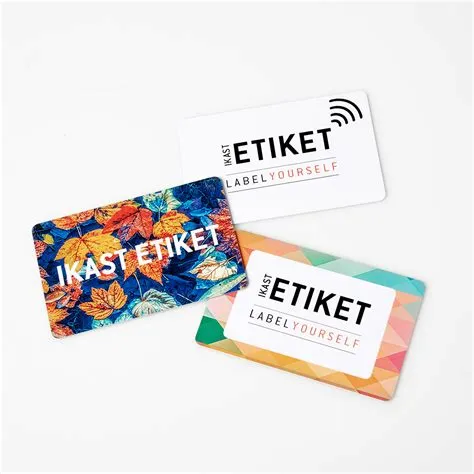Hey there! Let’s talk about something you might not think is all that exciting – ID cards. But hold on, because the world of business ID card design is exploding with innovation! We’re moving beyond the boring, generic plastic rectangles and embracing creativity, sustainability, and cutting-edge technology. Think of it as a mini-revolution in the pocket-sized world of identification.
Gone are the days of bland, impersonal cards. Today, ID cards are powerful branding tools, sophisticated security devices, and even reflections of a company’s values. Want to know what’s hot in ID card design right now? Let’s dive in!
The Rise of Sustainable ID Cards: Going Green is the New Black
Sustainability is no longer a niche concern; it’s a mainstream expectation. Consumers are increasingly conscious of environmental impact, and businesses are responding by adopting eco-friendly practices. This shift has directly influenced ID card design, with a growing demand for sustainable materials and printing techniques. Want to make a statement about your company’s commitment to the planet? Then sustainable ID cards are the perfect way to do it. Imagine the impact of showcasing your eco-conscious values on every employee’s ID!
Many companies are now choosing recycled materials like rPET (recycled polyethylene terephthalate) or plant-based plastics. This not only reduces waste but also reduces your company’s carbon footprint. You can even explore eco-friendly ID card materials that are biodegradable, creating a truly circular economy for your identification system. It’s a win-win: you get a stylish ID card and contribute positively to the environment.
Furthermore, exploring eco-friendly printing techniques is a must. This could involve using soy-based inks, water-based coatings, or even reducing the amount of ink used through smart design. These small changes can make a huge difference in the overall environmental impact of your ID cards.
Beyond the Basics: Functionality Meets Style
Think of your business ID card as more than just a piece of plastic; it’s a multi-functional tool. Today’s designs integrate technology and functionality, offering a seamless user experience. Consider the possibilities: imagine an ID card that doubles as a building access key, a payment card, or even a digital health passport. It’s not science fiction; it’s happening now.
Integration with smartphones is another trend taking center stage. Digital IDs and virtual ID cards are becoming increasingly popular, eliminating the need for physical cards in many situations. This is particularly useful for remote teams and businesses that value flexibility. Isn’t it convenient to simply scan a QR code on your phone to verify your identity?
For those still using physical cards, incorporating technology-integrated ID cards is a brilliant strategy. This could include embedded microchips for data storage, contactless payment capabilities, or even biometric scanners for enhanced security. It’s all about streamlining processes and maximizing efficiency.
Personalization and Customization: A Brand’s Best Friend
Think of your ID cards as miniature billboards for your brand. Why settle for a generic design when you can create a personalized masterpiece? Customization is key to creating a memorable and impactful ID card. You can showcase your company’s logo, colors, and fonts prominently, ensuring brand consistency and recognition. It’s a small detail with a big impact.
Don’t limit yourself to just the basics. Explore customization and personalization to create an ID that truly reflects your brand identity. This could involve adding unique textures, incorporating company imagery, or using innovative finishes like metallic accents. Think of it this way: a well-designed ID card is an extension of your brand, communicating professionalism and attention to detail.
Adding a touch of corporate branding with ID cards can significantly boost employee morale and external perception. When employees feel proud to represent your company, it shows. A beautifully designed ID card is a small but meaningful way to show appreciation and foster a sense of belonging.
Industry-Specific Designs: Tailoring to Your Needs
Every industry has its unique needs and requirements. One-size-fits-all ID cards simply won’t cut it. For example, a construction worker’s ID card will likely have different needs than a healthcare professional’s. Think safety features, security levels, and even the overall aesthetic.
Designing industry-specific ID cards is the key to creating truly effective identification solutions. Consider what information needs to be displayed, the level of security required, and any additional features that could be beneficial. For example, healthcare workers might need quick access to patient information, whereas construction workers might require a focus on safety protocols.
If you are considering design aspects, you will also find design trends in industry-specific ID cards crucial to implement. This reflects not only industry standards but also current design trends and best practices.
Security and Access Control: Protecting Your Assets
In today’s world, security is paramount. Your ID cards are not only a symbol of your brand but also a vital part of your security system. Integrating advanced security features into your ID card design is essential for protecting sensitive information and controlling access to your facilities.
This might involve incorporating holographic features, watermarks, or UV printing to prevent counterfeiting. You could also integrate biometric authentication, such as fingerprint scanning, for a higher level of security. Think of it as adding layers of protection to safeguard your business and its assets. The peace of mind is invaluable.
Investing in secure ID card systems and learning more about security and access control solutions is a crucial part of building a resilient business. The cost of inadequate security can far outweigh the investment in sophisticated ID card systems.
Embracing the Future: Trends to Watch
The world of ID card design is constantly evolving. New technologies and materials are emerging, pushing the boundaries of what’s possible. Staying ahead of the curve is crucial for businesses that want to maintain a competitive edge. What will the future hold? Well, the sky’s the limit!
We’re likely to see an increased adoption of digital IDs, further integration with mobile devices, and even more sophisticated security measures. The focus will remain on sustainability, with a continued drive towards eco-friendly materials and processes. Remember, your ID card is a reflection of your company’s values – make it count!
For more inspiration on designing modern and innovative IDs, check out these articles: Modern ID card design ideas and for information on the impact of your ID cards, read more about industry impact and benefits.
To find the perfect sustainable vendor for your business, consider exploring sustainable ID card vendors today and start creating truly impressive and eco-conscious ID cards.
Conclusion
In conclusion, the world of business ID card design is a dynamic and exciting space. By embracing innovation, sustainability, and personalization, businesses can create ID cards that are not only functional but also reflect their brand values and commitment to the environment. From eco-friendly materials to cutting-edge technology, the possibilities are endless. So, ditch the boring plastic and embrace the future of ID card design!
FAQs
- What are the most sustainable materials for ID cards? Many sustainable ID card vendors now offer recycled materials like rPET (recycled polyethylene terephthalate) or plant-based plastics. Consider the biodegradability and overall environmental impact when choosing a material.
- How can I integrate technology into my ID card design? Integration can range from embedding microchips for data storage to contactless payment capabilities or even biometric scanners for enhanced security. The possibilities are numerous and depend on your specific needs.
- What are the benefits of personalized ID card designs? Personalized designs strengthen brand identity, boost employee morale, and project a professional image. They also help prevent counterfeiting.
- How can I ensure my ID cards are secure? Incorporate security features like holographic elements, watermarks, UV printing, and potentially biometric authentication to safeguard your sensitive information and control access to your facilities.
- Where can I find sustainable ID card vendors? Research online to find suppliers who prioritize eco-friendly materials and printing techniques. Look for certifications and reviews to ensure quality and ethical sourcing. Also check out our blog for more details!

